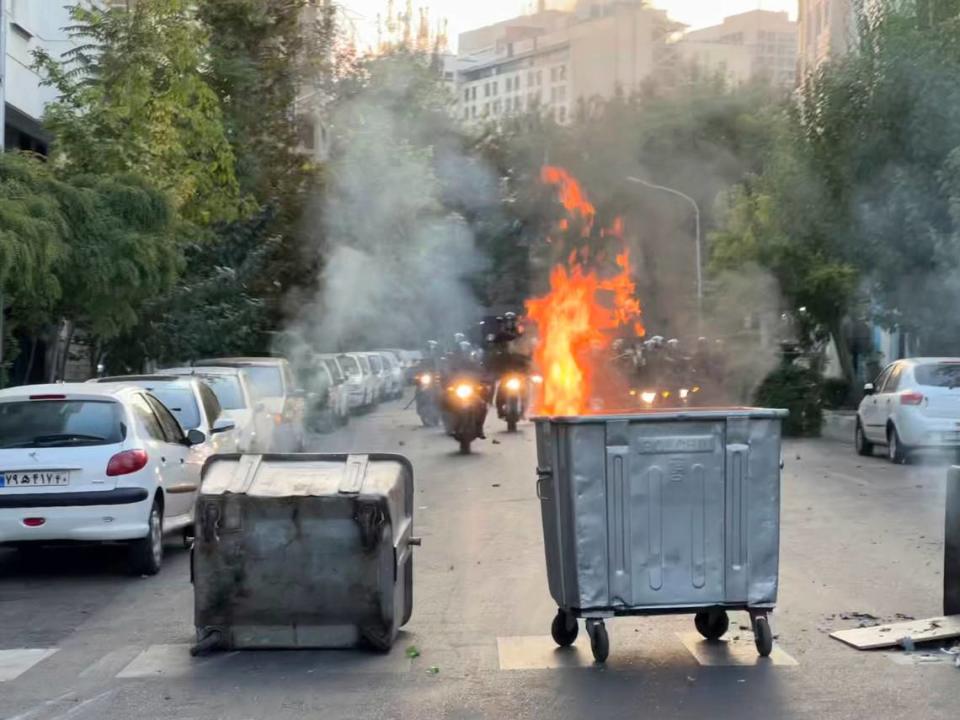Why are protesters in Iran blocking streets and burning their hijabs? What to know
Large-scale protests have erupted and spread across Iran following the death of a 22-year-old woman detained by the country’s Guidance Patrol — also known as the “morality police.”
The protests began after Mahsa Amini, a 22-year-old Iranian woman from Kurdistan, died on Sept. 16 in the custody of the morality police, The Associated Press reported. The protests have escalated and show no signs of slowing down.
Here’s everything you need to know.
What happened to Mahsa Amini?
While visiting Tehran, Amini was detained by the morality police on Sept. 13 when they said her clothing violated the country’s strict modesty dress code, the Washington Post reported. Amini was taken to the police station where she later collapsed. She was taken to a hospital and spent three days in a coma before she died, the outlet reported.
Iranian authorities said Amini had a heart attack while at the station, the AP reported.
Amini’s family rejected this explanation, according to an interview her father gave to Event24, translated by the Iran Center for Human Rights, saying she had no history of heart disease. The family and other activists have accused police of beating Amini, the Washington Post reported.
As news of Amini’s death spread, Iranians began taking to the streets in her home region and in the capital, Bloomberg reported. Protests spread to all major cities, drawing large crowds to the streets.
The president of Iran, Ebrahim Raisi, has promised an investigation into Amini’s death, the Associated Press reported.
Why are people in Iran protesting? What do they want?
Amini’s death served as the most recent trigger igniting underlying and ongoing anger among Iranians, particularly youth and women, Bloomberg reported.
People have begun protesting for a mixture of reasons, according to Bloomberg, the Washington Post, and the AP:
Some protesters want justice for Amini and accountability for those they consider responsible for her death.
Some protest against the violence and brutality of security forces and the impunity of involved authorities.
Some want requirements for hijab-wearing — a type of head covering obligatory for women by Iranian law — to end.
Other protesters express political and economic frustrations during protests.
Still others protest against the ultraconservative religious control of Islamic clerics — a set of social regulations enforced by the morality police.
What’s happening on the ground?
Protesters have flooded streets in Iran and social media worldwide. The current nationwide protests have grown into one of the largest challenges to Iran’s hardline conservative rules since the country’s 1979 revolution, Bloomberg reported.
On the ground, women are removing their hijabs and waving them around, changing “death to dictator,” video from Sept. 17 shows. A more recent video, from Sept. 21, shows people clapping and cheering as a woman stands atop a car, waving her hijab.
Some women have taken to burning their hijabs, as a video from Sept. 19 shows. In one clip, a woman dances toward a fire — hair flying free and uncovered — and drops her hijab in the fire, the video from Sept. 20 shows.
Another woman climbed atop a utility box and publicly cut her hair in protest, video from Sept. 20 shows.
Women of Iran-Saghez removed their headscarves in protest against the murder of Mahsa Amini 22 Yr old woman by hijab police and chanting:
death to dictator!
Removing hijab is a punishable crime in Iran. We call on women and men around the world to show solidarity. #مهسا_امینی pic.twitter.com/ActEYqOr1Q— Masih Alinejad ️ (@AlinejadMasih) September 17, 2022
فیلم مربوط به تصویر ماندگاری که این زن در تاریخ ثبت کرد.#اعتراضات_مردمی #مهسا_امینی #Mahsa_Amini https://t.co/JkdqtE19GI pic.twitter.com/ZII0SEsY91
— Moloud.Hajizadeh (@HajizadehMoloud) September 19, 2022
The real news of Iran is this not nuclear deal or Ebrahim Raisi’s speech at the UN.
Iranian women removing their hijab, facing guns and bullets alongside men and chanting against Islamic Republic.
Regime os cutting the internet in some cities. Be voice voiceless. #مهسا_امینی pic.twitter.com/l1zAZgEfoP— Masih Alinejad ️ (@AlinejadMasih) September 21, 2022
This is the real #Iran. Compulsory hejab is not part of our culture. #IranProtests #Mahsa_Amini #مهسا_امینی pic.twitter.com/3bLS5pTtzf
— Alireza Nader علیرضا نادر (@AlirezaNader) September 20, 2022
Unprecedented scenes in Iran: woman sits on top of utility box and cuts her hair in main square in Kerman to protest death of Mahsa Amini after her arrest by the morality police. People clap their hands and chant “Death to the dictator.” #مهسا_امینی pic.twitter.com/2oyuKV80Ac
— Golnaz Esfandiari (@GEsfandiari) September 20, 2022
These protests have been met with force from the Iranian government, the AP reports. Police have tried to dispel protesters with clubs, rubber bullets, tear gas, and live ammunition, the Washington Post reported. Police and protesters have met in violent clashes, photos from the AP show.

A Norway-based human rights organization, Hengaw, reported that at least 15 protesters have been killed by police and more than 700 people have been injured in the last five days.
Information from the ground is increasingly hard to get as the Iranian government increases communication restrictions, the Washington Post reported. The government has imposed some internet shutdowns, blocked Instagram and WhatsApp, and slowed or ended cellphone coverage in the country, the outlet reported.
What might happen next?
Iranian authorities — who have a pattern of using state-sanctioned violence to end public protests — have warned of escalating crackdowns if the protests do not stop, the Washington Post reported.
Iran’s army said in a statement on Friday, Sept. 23 that it will “confront the enemies,” referencing protesters, if they do not disperse, Reuters reported.
Currently, Iranians seem unlikely to stop protesting, the Washington Post reported.
Women burned holes in Dakota Access pipeline and set fire to equipment, officials say
Activist glues himself to bank — now he’s banned from taking glue outside, judge rules
Man ransacks Planned Parenthood in Oregon, then returns to do more damage, feds say


